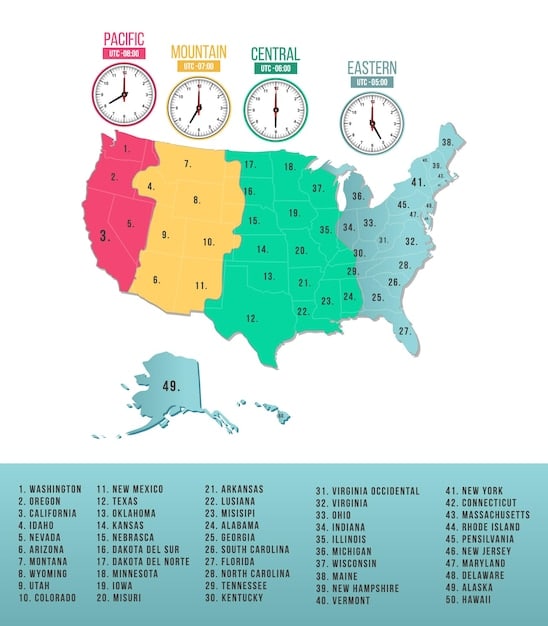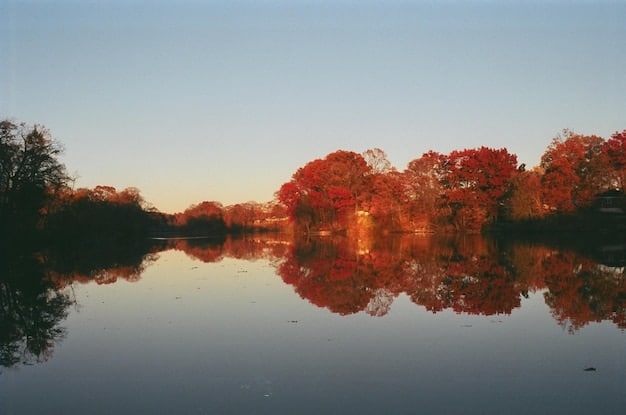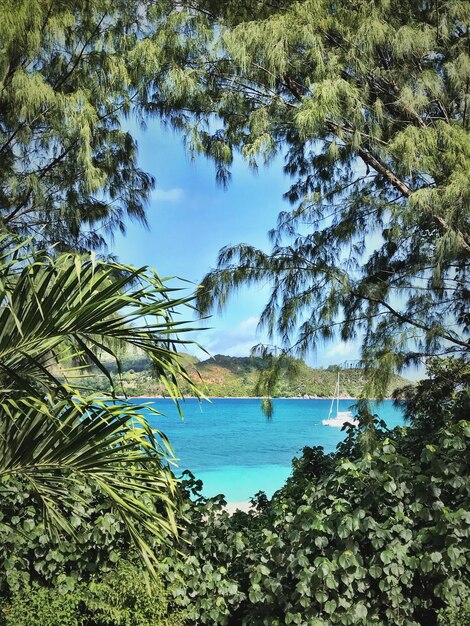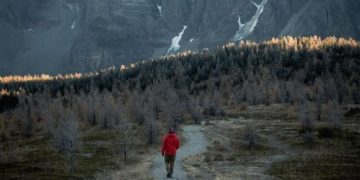US Travel: Best Time to Visit Each State in 2025

Navigating the optimal travel periods for the diverse American landscape, from coastal havens to mountain retreats, is essential for planning an unforgettable journey. This guide details the ideal times to visit each US state in 2025, ensuring travelers experience the best weather, cultural events, and outdoor activities.
Embarking on a journey across the United States offers a mosaic of experiences, from sun-drenched beaches to snow-capped peaks. To truly maximize your adventure, knowing the US Travel Guide: The Best Time to Visit Each State in 2025 is paramount, ensuring you capture each destination at its finest.
Planning Your 2025 US Getaway: A Seasonal Overview
The vastness of the United States means that while one region might be basking in glorious sunshine, another could be experiencing a winter wonderland or a dramatic monsoon season. Understanding the broad seasonal patterns across the country is the first step in meticulously planning your 2025 travels, ensuring your expectations align with reality.
Each season presents unique opportunities and challenges for travelers. For instance, summer is synonymous with national park adventures and beach escapades, but it also brings higher prices and larger crowds. Conversely, the shoulder seasons—spring and fall—often offer milder weather, fewer tourists, and potentially better deals, making them ideal for a more relaxed exploration.
Seasonal Considerations for Diverse States
- Spring (March-May): Ideal for visiting Southern states like Florida and Louisiana before the intense summer heat, or enjoying wildflowers in desert regions like Arizona and New Mexico. Northern states begin to thaw, revealing scenic beauty.
- Summer (June-August): Perfect for exploring the national parks of the West (e.g., Yellowstone, Yosemite) and coastal areas of New England or the Pacific Northwest. Be mindful of humidity in the South and Midwest.
- Fall (September-November): Unforgettable for leaf-peeping in New England and the Mid-Atlantic, wine country tours in California and Oregon, and mild temperatures across much of the country, avoiding peak summer crowds.
- Winter (December-February): Prime time for snow sports in mountain states like Colorado, Utah, and Vermont. Florida and Arizona offer warm escapes, while cities like New York and Chicago sparkle with holiday charm, despite the cold.
Considering regional climate variations and typical tourist flows will significantly enhance your travel experience, allowing you to tailor your itinerary to the most favorable conditions. This strategic approach minimizes unforeseen weather disruptions and maximizes enjoyment of local attractions.
Northeast USA: Best Time to Visit States in 2025
The Northeast, with its rich history, diverse landscapes, and distinct four seasons, offers a spectrum of travel experiences. From the bustling metropolises to serene coastal towns and majestic mountains, timing your visit is crucial to witnessing this region’s charm at its peak.
New England (Maine, New Hampshire, Vermont, Massachusetts, Rhode Island, Connecticut): The region truly shines in the fall (late September to mid-October) when the foliage transforms into an unparalleled display of reds, oranges, and golds. This period is magical for scenic drives, hiking, and enjoying crisp autumn air. Summer (July and August) is also popular, especially for coastal activities and lake resorts, though it can be crowded. Winter sports enthusiasts will find ideal conditions from December to March in Vermont and New Hampshire. Spring (April-May) is suitable for city breaks and escaping the crowds, with blooming flowers and milder temperatures.
Mid-Atlantic States (New York, Pennsylvania, New Jersey, Delaware, Maryland):
- New York: Fall (September-October) is superb for experiencing New York City with pleasant walking weather and vibrant parks, or for upstate leaf-peeping. Late spring (May-June) is also excellent for urban exploration and outdoor activities. Winter (December-February) embraces holiday festivities but can be severely cold.
- Pennsylvania: Autumn is spectacular for the Poconos and rural areas. Spring (April-May) and fall (September-October) are ideal for visiting historic Philadelphia and its surrounding attractions, offering comfortable temperatures.
- New Jersey & Delaware: Summer (June-August) is prime time for their famed Atlantic beaches. Shoulder seasons (late spring/early fall) offer a more relaxed beach experience with pleasant temperatures before the summer crowds arrive.
- Maryland: Spring (April-May) offers beautiful cherry blossoms and moderate temperatures, perfect for Baltimore and Annapolis. Fall (September-October) is equally appealing with comfortable weather for exploring historical sites and natural parks.
Understanding the microclimates within the Northeast is key. Coastal areas tend to have more moderate temperatures, while inland and mountainous regions experience more extreme heat in summer and cold in winter. This regional diversity means there’s almost always an ideal time to visit some part of the Northeast, depending on your interests.

Southeast USA: Best Time to Visit States in 2025
The American Southeast, known for its warm hospitality, rich history, and diverse natural beauty, spans from the Appalachian Mountains to the Gulf Coast. Its climate is largely characterized by hot, humid summers and mild winters, making timing a visit pivotal for comfort and enjoyment.
Florida: The ultimate warm escape during winter (November to April). This period offers pleasant temperatures, low humidity, and minimal rainfall, ideal for beaches, theme parks, and Everglades exploration. Summer (June-September) is hot, humid, and prone to afternoon thunderstorms and hurricane season, though attractive for budget travelers willing to brave the heat.
Gulf Coast & Deep South (Alabama, Mississippi, Louisiana):
- Louisiana: Early spring (March-April) is perfect for New Orleans, avoiding the intense summer heat and humidity while enjoying festivals like Jazz Fest. Fall (October-November) is also pleasant. Summer is very hot and humid.
- Alabama & Mississippi: Spring (March-May) and fall (September-November) offer the most comfortable weather for exploring historic sites, antebellum homes, and natural parks. Summers can be oppressively hot and humid.
Georgia & Carolinas (Georgia, North Carolina, South Carolina): Spring (April-May) brings blooming dogwoods and azaleas, making cities like Charleston, Savannah, and Asheville particularly picturesque. Fall (September-October) is excellent for mountain getaways in North Carolina and mild coastal weather in South Carolina. Summers are hot and humid, especially along the coast.
Mid-South & Appalachian States (Kentucky, Tennessee, West Virginia, Virginia):
These states offer distinct seasonal variations. Fall (September-October) is magnificent for the Blue Ridge Mountains and Shenandoah National Park in Virginia, and for exploring the Great Smoky Mountains National Park in Tennessee and North Carolina, with vibrant foliage. Spring (April-May) offers pleasant temperatures for hiking and city tours. Summers can be warm, and winters bring cold and occasional snow, especially in higher elevations. Kentucky and Tennessee are also fantastic in the spring for horse racing events like the Kentucky Derby.
Overall, for the Southeast, the shoulder seasons of spring and fall generally offer the most agreeable weather conditions for broad exploration, balancing comfortable temperatures with fewer crowds compared to peak summer. Winter remains a popular choice for those seeking warmth, particularly in Florida and along the Gulf Coast.
Midwest USA: Best Time to Visit States in 2025
The Midwest offers a unique blend of sprawling farmlands, vibrant cities, and Great Lakes beauty. Its continental climate is marked by distinct seasons, making timing a key factor for travelers looking to experience everything from urban cultural sites to pastoral landscapes and lakeside adventures.
Illinois & Ohio Valley (Illinois, Indiana, Ohio): Spring (April-May) and fall (September-October) are generally the best times to visit these states. The mild temperatures are ideal for exploring cities like Chicago, Columbus, and Indianapolis, enjoying outdoor festivals, and visiting historical sites. Summers (June-August) can be hot and humid, while winters (December-February) are cold with significant snowfall, especially in northern areas.
Great Lakes States (Michigan, Wisconsin, Minnesota):
- Michigan: Summer (July-August) is prime for exploring the Great Lakes shoreline, enjoying water sports, and visiting islands like Mackinac. Fall (late September-October) is also popular for foliage viewing, particularly in the Upper Peninsula. Winters are very cold and snowy, ideal for winter sports.
- Wisconsin: Summer (June-August) offers pleasant weather for lakeside activities and city exploration in Milwaukee and Madison. Fall (September-October) brings beautiful autumn colors, especially in the northern forests. Winter is cold and snowy.
- Minnesota: Summer (June-August) is undoubtedly the best time, with warmer temperatures for outdoor activities, lake enjoyment, and exploring Minneapolis and St. Paul. Fall (September-October) also has pleasant weather and some foliage. Winters are famously long and very cold, with substantial snow.
Plains States (Iowa, Missouri, Kansas, Nebraska, South Dakota, North Dakota): The shoulder seasons of spring (late April-June) and fall (September-October) are ideal across most of the Plains. These periods offer comfortable temperatures for exploring national parks like Badlands and Mount Rushmore in South Dakota, visiting major cities, and enjoying the vast open spaces. Summers (July-August) can be very hot, especially in the southern Plains, and thunderstorms are common. Winters (December-February) are cold and often windy, with snow and occasional blizzards. For North and South Dakota, specifically, late spring and early fall give the best combination of agreeable weather and manageable crowds for sites like the Black Hills and Theodore Roosevelt National Park.
Despite the potential for extreme temperatures, each season in the Midwest holds its own unique appeal. Travelers seeking warmth and outdoor recreation will find summer rewarding, while those interested in cultural exploration and scenic beauty will appreciate the spring and fall.
Southwest USA: Best Time to Visit States in 2025
The American Southwest is a region of dramatic landscapes, vibrant cultures, and unique ecosystems, ranging from arid deserts to alpine forests. The key to enjoying this region is understanding its intense climate, where temperatures can swing significantly between day and night, and seasons can be sharply defined.
Desert States (Arizona, Nevada): Spring (March-May) and fall (October-November) are by far the best times to visit. During these periods, temperatures are pleasantly warm during the day and cool at night, making it ideal for hiking in national parks like Grand Canyon, Zion, and Arches (though Zion & Arches are technically in Utah, they follow similar climate patterns as Arizona/Nevada for travel planning). Las Vegas is also more enjoyable in these seasons, avoiding the scorching summer heat. Summer (June-September) in the low desert areas (e.g., Phoenix, Las Vegas) sees extreme temperatures often exceeding 100°F (38°C), making outdoor activities challenging. Winter (December-February) offers mild days but cold nights, with snow possible at higher elevations like the Grand Canyon rim.
New Mexico & Texas:
- New Mexico: Fall (September-October) is wonderful for its mild temperatures, vibrant art scene, and captivating cultural festivals, such as the Albuquerque International Balloon Fiesta (early October). Spring (April-May) is also pleasant. Summers can be hot, especially in the southern parts, and winters are cold with snow in the mountains.
- Texas: Spring (March-May) is fantastic across most of the state, with blooming wildflowers (especially bluebonnets), comfortable temperatures, and bustling city life in Austin, Dallas, and Houston. Fall (September-November) is similarly agreeable. Summers (June-August) are notoriously hot and humid, particularly in the eastern and southern regions. Winters are generally mild, though cold snaps can occur.
Oklahoma: Spring (April-May) and fall (September-October) offer the most comfortable weather for exploring Oklahoma City, Tulsa, and the state’s diverse landscapes. Spring brings the risk of severe thunderstorms and tornadoes, so travelers should stay weather-aware. Summers are hot and humid, while winters are cold and can have ice storms.
For outdoor enthusiasts and those looking to explore the natural wonders of the Southwest, aiming for the shoulder seasons is highly recommended. If visiting in summer, focus on higher-elevation areas or indoor attractions, and always be prepared for intense heat and sun protection.
Rocky Mountains USA: Best Time to Visit States in 2025
The Rocky Mountain states, renowned for their majestic peaks, pristine wilderness, and world-class skiing, demand careful timing for visits. The region experiences dramatic seasonal shifts, largely influenced by elevation, offering distinct attractions in summer, winter, and the shoulder seasons.
Colorado: Winter (December-March) is prime time for skiing and snowboarding in its famous resorts like Aspen, Vail, and Breckenridge. Summer (June-August) is equally popular for hiking, mountain biking, and exploring national parks like Rocky Mountain National Park, with comfortable warm days and cool nights. The shoulder seasons (April-May and September-November) offer fewer crowds and beautiful landscapes as snow melts or fall colors emerge, but some higher elevation roads and trails may be closed.
Montana & Wyoming:
- Montana: Summer (June-August) is the best time for Glacier National Park, although parts of the iconic Going-to-the-Sun Road may not fully open until late June or early July due to snow. This also applies to Yellowstone National Park, which straddles Wyoming and Montana. Fall (September-October) offers crisp air and fewer crowds, with some stunning foliage. Winters are bitterly cold and snowy.
- Wyoming: Similar to Montana, summer (June-August) is ideal for Yellowstone and Grand Teton National Parks, offering the best access to trails and wildlife viewing. Fall (September-October) is also excellent for wildlife and fall colors, with fewer visitors. Winter brings deep snow, turning the parks into tranquil, snow-covered landscapes accessible primarily to snowmobilers and cross-country skiers.
Idaho & Utah:
* Idaho: Summer (June-August) is fantastic for outdoor activities, from white-water rafting on the Salmon River to exploring the scenic Sawtooth Mountains. Fall (September-October) brings pleasant weather for hiking and fishing. Winter (December-March) is excellent for skiing, particularly in Sun Valley.
* Utah: Spring (April-May) and fall (September-October) are arguably the best times to visit Utah’s “Mighty 5” national parks (Zion, Bryce Canyon, Arches, Canyonlands, Capitol Reef), offering comfortable temperatures for hiking and avoiding the intense summer heat. Winter is popular for skiing at resorts like Park City. Summer can be very hot in the lower-elevation parks.
Regardless of the season, visitors to the Rocky Mountains should be prepared for rapidly changing weather conditions, especially at higher altitudes. Proper layering and awareness of weather forecasts are crucial for an enjoyable and safe trip.
Pacific Northwest & West Coast USA: Best Time to Visit States in 2025
The West Coast and Pacific Northwest offer an incredible range of climates and attractions, from rugged coastlines and dense forests to sprawling deserts and cosmopolitan cities. Each state boasts unique seasonal appeals, making careful planning essential for the optimal experience.
California: This vast state offers year-round opportunities depending on the region. For coastal areas (e.g., San Francisco, Los Angeles, San Diego), late spring (May-June) and early fall (September-October) offer pleasant temperatures, less fog (in San Francisco), and fewer crowds than peak summer. Summer (July-August) is ideal for beaches and national parks like Yosemite and Redwood, though Yosemite can be crowded. Winter (December-April) is prime for skiing in the Sierra Nevada mountains and offers a mild, often rainy escape in Southern California. The desert regions (e.g., Death Valley, Joshua Tree) are best visited in fall, winter, or spring, avoiding the extreme summer heat.
Oregon & Washington:
- Oregon: Summer (July-August) is generally the driest and warmest period, perfect for exploring the Oregon Coast, Crater Lake National Park, and indulging in outdoor activities. Fall (September-October) is ideal for wine tasting in the Willamette Valley and enjoying vibrant foliage, with milder weather. Spring (April-May) sees more rain but beautiful blooms. Winters are wet, especially along the coast and in the Cascade Mountains, with snow at higher elevations.
- Washington: Similar to Oregon, summer (July-August) is unsurpassed for exploring national parks like Olympic, Mount Rainier, and North Cascades, as well as enjoying Puget Sound and hiking. Fall (September-October) offers crisp air and beautiful autumn colors inland, with fewer visitors. Spring (April-May) is greener but still prone to rain. Winters are typically rainy in the lowlands (e.g., Seattle) and snowy in the mountains, offering excellent skiing.
Alaska: Summer (June-August) is the undisputed best time to visit Alaska. During these months, temperatures are mild, daylight hours are incredibly long, and all major tourist attractions, national parks, and wildlife viewing opportunities are fully accessible. This is the peak season for cruising, fishing, hiking, and wildlife viewing. Spring (May) and fall (September) are shoulder seasons with fewer crowds but potentially more unpredictable weather and reduced services. Winters (October-April) are extremely cold and dark, suitable primarily for aurora borealis viewing and winter sports.
When planning a trip to the West Coast and Pacific Northwest, flexibility and an understanding of regional microclimates are invaluable. While summers are generally excellent across the board, the shoulder seasons often provide a more serene and equally beautiful experience.
Hawaii & US Territories: Best Time to Visit in 2025
Hawaii, a tropical paradise, along with the various US territories, offers unique travel experiences distinct from the mainland. Their climates are generally tropical or subtropical, meaning less dramatic seasonal shifts than the continental US, but still with specific periods that are more favorable for visitors.
Hawaii: There isn’t a “bad” time to visit Hawaii, but the best time generally falls from mid-December to May. This period avoids the hotter, more humid summer months and the hurricane season (June-November), which although rare, can bring heavier rains and stronger winds, especially from July to November. January to March is popular for whale watching, as humpback whales migrate to the warmer waters. The shoulder seasons (April-May and September-October) offer slightly fewer crowds and good weather. Prices for flights and accommodation tend to be higher during peak seasons like Christmas, New Year’s, and Spring Break.
US Territories (Puerto Rico, US Virgin Islands, Guam, American Samoa, Northern Mariana Islands):
- Puerto Rico & US Virgin Islands: Similar to Hawaii, the best time to visit these Caribbean territories is generally from December to May, avoiding the peak hurricane season (June-November) and the hottest, most humid summer months. The weather during this period is typically dry, sunny, and pleasantly warm, ideal for beaches, water sports, and exploring historical sites. Prices are highest during the winter holidays.
- Guam & Northern Mariana Islands: These Pacific territories have a tropical monsoon climate. The dry season (December-June) is often considered the best time to visit, characterized by less humidity and lower rainfall. The wet season (July-November) brings higher humidity and more frequent, though often brief, downpours. Typhoon season typically falls from July to November, similar to the hurricane season in the Atlantic.
- American Samoa: This South Pacific territory has a warm, humid tropical climate year-round. The drier period, typically from May to October, is generally preferred for travel, offering slightly less rainfall and humidity, making outdoor activities more comfortable. The wetter season runs from November to April. Typhoons can occur during the wet season.
For all these tropical destinations, flexibility is key. While there are optimal periods, favorable weather can occur outside these windows, and travel during the “off-season” can sometimes yield better deals on flights and accommodations, albeit with a slightly higher risk of rain or extreme weather events. Always check weather advisories before and during your trip.

The comprehensive guide above provides a robust framework for planning your 2025 US travels. Armed with this knowledge, you are better equipped to select the perfect timing for your adventures, ensuring memorable experiences across the diverse landscapes of America. From pristine beaches to majestic mountains and vibrant cities, understanding seasonal nuances elevates your journey from good to extraordinary, minimizing logistical challenges and maximizing enjoyment.
| Key Travel Aspect | Brief Description |
|---|---|
| ☀️ Optimal Seasons | Generally spring and fall for most states, offering mild weather and fewer crowds. |
| 🏞️ National Parks | Best visited in summer (North/Mountains) or shoulder seasons (Southwest). |
| 🏖️ Beach Destinations | Peak in summer for Atlantic/Pacific, winter for Florida/Caribbean. |
| ❄️ Winter Sports | December to March in mountainous states (Colorado, Utah, Vermont). |
Frequently Asked Questions About US Travel in 2025
▼
For general sightseeing across diverse regions of the USA, May or September are often considered the best months. These shoulder seasons typically offer pleasant temperatures, fewer crowds compared to peak summer, and beautiful natural scenery, whether it’s spring blooms or early fall foliage, making for a comfortable and enjoyable travel experience.
▼
Hurricane season in the Atlantic (affecting the Southeast and Caribbean) runs from June 1st to November 30th, peaking in August and September. The Pacific hurricane season (affecting Hawaii and some West Coast areas) is roughly May 15th to November 30th. While direct hits are rare, it’s wise to monitor forecasts and consider travel insurance for trips during these months to coastal regions.
▼
While most states have distinct peak seasons, certain regions of California (especially Southern California) and Florida enjoy a relatively mild climate year-round, allowing for comfortable travel. Hawaii also offers a consistently warm, tropical climate throughout the year, making it a viable destination almost any month, though some periods are drier or less humid.
▼
Traveling during shoulder seasons (spring and fall) in the US often provides several benefits. These include milder weather conditions, fewer crowds at popular attractions, and potentially lower prices for accommodation and flights. This allows for a more relaxed and authentic travel experience, avoiding the extremes of summer heat or winter cold.
▼
Climate change is indeed shifting traditional travel seasons. We’re seeing more extreme weather events, longer heatwaves, and changing precipitation patterns. This means “best times” can become less predictable, with some areas experiencing extended hot seasons or altered peak bloom/foliage times. Travelers should always check current weather forecasts and consider flexibility in their plans.
Conclusion
Navigating the vast and varied landscapes of the United States in 2025 demands a strategic approach to timing, as each state offers its unique allure across different seasons. By understanding the climatic nuances and peak activity periods for each region, travelers can significantly enhance their experiences, ensuring that their journeys are filled with optimal weather, vibrant cultural immersion, and access to the best natural attractions. Whether seeking the warmth of a Floridian winter or the fiery hues of New England’s autumn, thoughtful planning is the compass to an unforgettable American adventure.





